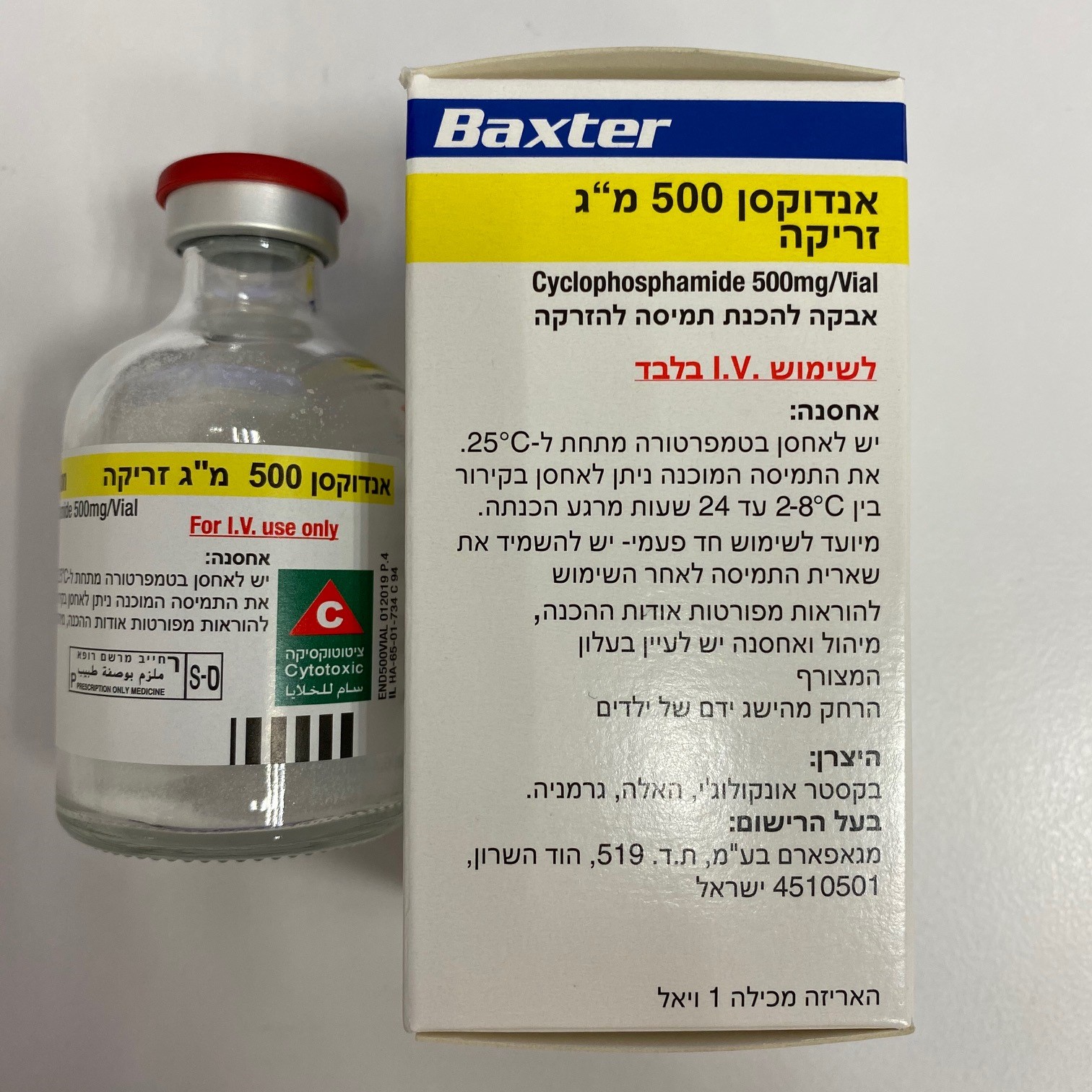Quest for the right Drug

אנדוקסן 500 מ"ג זריקה ENDOXAN 500 MG INJECTION (CYCLOPHOSPHAMIDE)
תרופה במרשם
תרופה בסל
נרקוטיקה
ציטוטוקסיקה
צורת מתן:
תוך-ורידי : I.V
צורת מינון:
אבקה להכנת תמיסה לזריקה : POWDER FOR SOLUTION FOR INJECTION
עלון לרופא
מינוניםPosology התוויות
Indications תופעות לוואי
Adverse reactions התוויות נגד
Contraindications אינטראקציות
Interactions מינון יתר
Overdose הריון/הנקה
Pregnancy & Lactation אוכלוסיות מיוחדות
Special populations תכונות פרמקולוגיות
Pharmacological properties מידע רוקחי
Pharmaceutical particulars אזהרת שימוש
Special Warning עלון לרופא
Physicians Leaflet
Pregnancy & Lactation : הריון/הנקה
4.6 Fertility, pregnancy and lactation Pregnancy Cyclophosphamide is contraindicated in pregnancy (see section 4.3). Cyclophosphamide crosses the placental barrier. Treatment with cyclophosphamide has a genotoxic effect and may cause foetal damage when administered to pregnant women. Both women and men should wait at least 6 to 12 months after stopping Cyclophosphamide before attempting to conceive or father a child. • Malfor atio s ha e ee reported i hildre or to others treated ith cyclophosphamide during the first trimester of pregnancy. However, there are also reports of children without malformations born to women exposed during the first trimester. • E posure to lophospha ide i utero a ause is arriage, foetal gro th retardatio , and foetotoxic effects manifesting in the newborn, including leukopenia, anemia, pancytopenia, severe bone marrow hypoplasia, and gastroenteritis. • A i al data suggest that a i reased risk of failed preg a a d alfor atio s a persist after discontinuation of cyclophosphamide as long as oocytes/follicles exist that were exposed to cyclophosphamide during any of their maturation phases. See Section 4.4, Genotoxicity. • If lophospha ide is used duri g preg a , or if the patie t e o es preg a t hile taking this drug or after treatment (see Section 4.4, Genotoxicity), the patient should be apprised of the potential hazard to a foetus. Lactation Cyclophosphamide is passed into the breast milk. Neutropenia, thrombocytopenia, low hemoglobin, and diarrhoea have been reported in children breast fed by women treated with cyclophosphamide. Women must not breastfeed during treatment with cyclophosphamide. Fertility Cyclophosphamide interferes with oogenesis and spermatogenesis. It may cause sterility in both sexes. Development of sterility appears to depend on the dose of cyclophosphamide, duration of therapy, and the state of gonadal function at the time of treatment. Cyclophosphamide-induced sterility may be irreversible in some patients. Sexually active women and men should use effective methods of contraception during these periods of time. • Fe ale patie ts Amenorrhea, transient or permanent, associated with decreased oestrogen and increased gonadotrophin secretion develops in a significant proportion of women treated with cyclophosphamide. For older women, in particular, amenorrhea may be permanent. Oligomenorrhea has also been reported in association with cyclophosphamide treatment. Girls treated with cyclophosphamide during prepubescence generally develop secondary sexual characteristics normally and have regular menses. Girls treated with cyclophosphamide during prepubescence subsequently have conceived. Girls treated with cyclophosphamide who have retained ovarian function after completing treatment are at increased risk of developing premature menopause (cessation of menses before age of 40 years). • Male patie ts Men treated with cyclophosphamide may develop oligospermia or azoospermia, which are normally associated with increased gonadotrophin but normal testosterone secretion. Sexual potency and libido generally are unimpaired in these patients. Boys treated with cyclophosphamide during prepubescence may develop secondary sexual characteristics normally but may have oligospermia or azoospermia. Some degree of testicular atrophy may occur. Cyclophosphamide-induced azoospermia is reversible in some patients, though the reversibility may not occur for several years after cessation of therapy.

שימוש לפי פנקס קופ''ח כללית 1994
Hodgkin's disease, malignant lymphomas, multiple myeloma, mycosis fungoides, neuroblastoma, autoimmune disease
תאריך הכללה מקורי בסל
01/01/1995
הגבלות
תרופה מוגבלת לשימוש בבתי חולים או אשפוז יום
מידע נוסף
